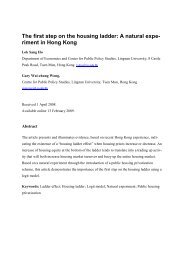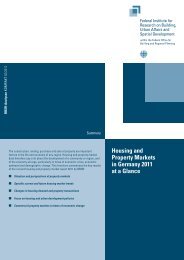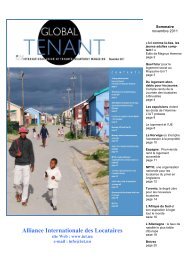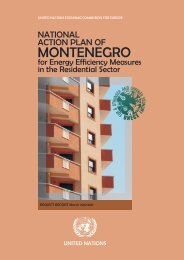housing developments in european countries - Department of ...
housing developments in european countries - Department of ...
housing developments in european countries - Department of ...
Create successful ePaper yourself
Turn your PDF publications into a flip-book with our unique Google optimized e-Paper software.
Section 4<br />
Outcomes<br />
Outcomes Section 4<br />
Denmark and Slovenia are the only ‘low output’<br />
<strong>countries</strong> where house build<strong>in</strong>g levels have risen <strong>in</strong> the<br />
recent past. In the former, output has risen significantly<br />
from 2.9 dwell<strong>in</strong>gs per 1,000 <strong>in</strong>habitants <strong>in</strong> 2000 to<br />
4.5 dwell<strong>in</strong>gs per 1,000 <strong>in</strong> 2003. However, Slovenian<br />
<strong>hous<strong>in</strong>g</strong> output has risen only marg<strong>in</strong>ally <strong>in</strong> recent<br />
years – from 3 dwell<strong>in</strong>gs per 1,000 population <strong>in</strong> 1996<br />
to 3.1 per 1,000 <strong>in</strong> 2000. Moreover, these recent<br />
<strong>in</strong>creases have been <strong>in</strong>sufficient to fully reverse the<br />
sharp reduction <strong>in</strong> <strong>hous<strong>in</strong>g</strong> output <strong>in</strong> the country<br />
dur<strong>in</strong>g the early 1990s. In the period between 1980<br />
and 1990, 10,000 to 14,000 dwell<strong>in</strong>gs or 5 to 7<br />
dwell<strong>in</strong>gs per 1,000 <strong>in</strong>habitants, were constructed<br />
annually <strong>in</strong> Slovenia.<br />
FIGURE 4.2.1 also reveals that <strong>in</strong> 2000, levels <strong>of</strong> new<br />
house build<strong>in</strong>g <strong>in</strong> a number <strong>of</strong> <strong>countries</strong> were at or<br />
below 2.5 dwell<strong>in</strong>gs per 1,000 <strong>in</strong>habitants and could<br />
therefore be categorised as very low <strong>in</strong> the wider<br />
European context. The <strong>countries</strong> <strong>in</strong> this category are:<br />
■ Bulgaria: 1.1 dwell<strong>in</strong>gs per 1,000 <strong>in</strong>habitants;<br />
■ Czech Republic: 2.5 dwell<strong>in</strong>gs per 1,000<br />
<strong>in</strong>habitants;<br />
■ Hungary: 2.15 dwell<strong>in</strong>gs per 1,000 <strong>in</strong>habitants;<br />
■ Latvia: 0.40 dwell<strong>in</strong>gs per 1,000 <strong>in</strong>habitants;<br />
■ Lithuania: 1.2 dwell<strong>in</strong>gs per 1,000 <strong>in</strong>habitants;<br />
■ Poland: 2.3 dwell<strong>in</strong>gs per 1,000 <strong>in</strong>habitants;<br />
■ Romania: 1.3 dwell<strong>in</strong>gs per 1,000 <strong>in</strong>habitants;<br />
■ Slovakia: 2.39 dwell<strong>in</strong>gs per 1,000, and<br />
■ Sweden with 1.7 per 1,000 <strong>in</strong>habitants.<br />
Moreover, <strong>in</strong> most <strong>of</strong> these <strong>countries</strong> <strong>hous<strong>in</strong>g</strong> output<br />
rates dropped sharply after the <strong>in</strong>troduction <strong>of</strong> the<br />
market economy <strong>in</strong> the early 1990s and has not s<strong>in</strong>ce<br />
rega<strong>in</strong>ed its earlier levels. In Lithuania, for example,<br />
residential construction fell from 22,100 units <strong>in</strong> 1990<br />
to 3,785 dwell<strong>in</strong>gs <strong>in</strong> 2001. Poland, Romania, Bulgaria<br />
and Slovakia experienced similarly dramatic falls <strong>in</strong><br />
<strong>hous<strong>in</strong>g</strong> output <strong>in</strong> the early 1990s.<br />
However, <strong>in</strong> recent years some <strong>of</strong> these <strong>countries</strong> have<br />
begun to reverse this decl<strong>in</strong>e. In Slovakia, <strong>hous<strong>in</strong>g</strong><br />
output rose from 1.3 per 1,000 <strong>in</strong>habitants (or 7,172<br />
units) <strong>in</strong> 1997 to 2.6 per 1,000 <strong>in</strong>habitants (or 14,213<br />
units) <strong>in</strong> 2002. Polish <strong>hous<strong>in</strong>g</strong> output rose from 62,130<br />
dwell<strong>in</strong>gs <strong>in</strong> 1997 (which constitutes 1.6 per 1,000<br />
population) to 163,578 dwell<strong>in</strong>gs (or 4.3 per 1,000<br />
population) <strong>in</strong> 2003. In this regard, Romania and<br />
Bulgaria are an exception to the norm for new Central<br />
and Eastern European EU member and applicant<br />
States. After a sharp drop <strong>in</strong> 1989-1990, the total<br />
yearly production <strong>of</strong> new <strong>hous<strong>in</strong>g</strong> <strong>in</strong> Romania<br />
averaged at around 30,000 units until 2002, when the<br />
total number <strong>of</strong> new dwell<strong>in</strong>gs built was 27,722. In<br />
Bulgaria <strong>hous<strong>in</strong>g</strong> output fell from 17,996 units <strong>in</strong> 1992<br />
(2.1 dwell<strong>in</strong>gs per 1,000 population), to 6,153 units<br />
(0.8 dwell<strong>in</strong>gs per 1,000 population) <strong>in</strong> 2002.<br />
4.2.2 Micro-Level Supply<br />
Disaggregated data regard<strong>in</strong>g trends <strong>in</strong> <strong>hous<strong>in</strong>g</strong> output<br />
by tenure are not available for all <strong>of</strong> the 28 <strong>countries</strong><br />
exam<strong>in</strong>ed <strong>in</strong> this report. However, the data that are<br />
available highlight significant <strong>in</strong>ter-tenure variations <strong>in</strong><br />
new house build<strong>in</strong>g across Europe. These data are set<br />
out <strong>in</strong> TABLE 4.2.2.<br />
Table<br />
4.2.2<br />
Trends <strong>in</strong> New House Build<strong>in</strong>g <strong>in</strong> European Countries by Tenure, 1995-2003<br />
Country Tenure 1995 1996 1997 1998 1999 2000 2001 2002 2003<br />
Austria Owner occupied Nav Nav Nav Nav Nav Nav Nav 66 Nav<br />
Rented Nav Nav Nav Nav Nav Nav Nav 29 Nav<br />
Other Nav Nav Nav Nav Nav Nav Nav 5 Nav<br />
Bulgaria Public 46.5 31.5 26.5 21.7 16.6 9.6 10.4 11.8 Nav<br />
Private 53.5 68.5 73.7 78.3 83.4 90.4 89.6 88.2 Nav<br />
Czech Republic Municipal 26.1 Nav Nav Nav Nav Nav Nav Nav Nav<br />
Co-operative 9.3 Nav Nav Nav Nav Nav Nav Nav Nav<br />
Employer 6.2 Nav Nav Nav Nav Nav Nav Nav Nav<br />
Private 58.2 Nav Nav Nav Nav Nav Nav Nav Nav<br />
Denmark Non-pr<strong>of</strong>it Nav Nav Nav Nav Nav Nav Nav 42.7 47.7<br />
Co-operative Nav Nav Nav Nav Nav Nav Nav 5.9 9.8<br />
Private rented Nav Nav Nav Nav Nav Nav Nav 5.9 7.9<br />
Owner occupied Nav Nav Nav Nav Nav Nav Nav 45.5 34.6<br />
France Social 22.4 20.1 17.2 15.5 12.9 13.3 12.2 12.5 Nav<br />
Subsidised private 15.9 32.6 36.4 31.8 30.6 30.4 28.4 28.7 Nav<br />
Private 61.7 47.3 46.4 52.7 56.5 56.3 59.4 59.4 Nav<br />
Ireland Social Nav Nav Nav Nav 7.5 6 9.3 10 8.9<br />
Private Nav Nav Nav Nav 92.5 94 90.7 90 91.1<br />
Netherlands Rented 31 Nav Nav Nav Nav 21.5 Nav 19 Nav<br />
Owner occupied 69 Nav Nav Nav Nav 78.5 Nav 81 Nav<br />
Poland Co-operative Nav 39.7 38.2 35 33.5 28.2 24.5 15.8 7.3<br />
Municipal Nav 4.8 5.1 4.2 3.3 2.1 2.2 2.6 1.3<br />
Enterprises Nav 2.6 1.9 1.7 1.2 1.3 0.9 0.6 0.6<br />
Private Nav 52.8 54.4 57.4 57.9 64 66.4 76.2 87.2<br />
Social Nav 09 0.4 1.7 4.1 4.4 6.2 4.8 3.6<br />
Slovakia Municipal Nav Nav 26 16.3 7.7 5.2 10.5 16.8 Nav<br />
Co-operative Nav Nav 13.2 6.7 6.3 0.8 0.5 1.9 Nav<br />
Other Nav Nav 4.8 2.4 2.9 2.5 2.4 0.7 Nav<br />
Private Nav Nav 56 74.6 83.1 91.5 86.6 80.6 Nav<br />
Note: Data for the follow<strong>in</strong>g <strong>countries</strong> are not available: Belgium, Cyprus, Estonia, F<strong>in</strong>land, Germany, Greece, Hungary, Italy, Latvia, Lithuania,<br />
Luxembourg, Malta, Portugal, Romania, Slovenia, Spa<strong>in</strong>, Sweden, Turkey, United K<strong>in</strong>gdom.<br />
Although data on <strong>hous<strong>in</strong>g</strong> output per head <strong>of</strong><br />
This table reveals that output <strong>of</strong> social rented and co-<br />
Detailed data regard<strong>in</strong>g social house build<strong>in</strong>g <strong>in</strong> the<br />
built (almost all <strong>of</strong> which were social <strong>hous<strong>in</strong>g</strong>), social<br />
population <strong>in</strong> Estonia were unobta<strong>in</strong>able, the available<br />
operative <strong>hous<strong>in</strong>g</strong> has fallen significantly s<strong>in</strong>ce 1995 <strong>in</strong><br />
Czech Republic <strong>in</strong> recent years were also unavailable,<br />
<strong>hous<strong>in</strong>g</strong> construction <strong>in</strong> this country dropped<br />
<strong>in</strong>formation <strong>in</strong>dicates that this country also qualifies<br />
Bulgaria, France and Poland, although <strong>in</strong> the latter<br />
but the Czech government’s response to the survey on<br />
significantly <strong>in</strong> 2002 and 2003. In 2003, total output<br />
for <strong>in</strong>clusion <strong>in</strong> the very low output category. In 2002,<br />
country output by social <strong>hous<strong>in</strong>g</strong> associations, which<br />
which this review is based emphasises that the private<br />
<strong>in</strong> this tenure was just under 6,000 dwell<strong>in</strong>gs. In<br />
new dwell<strong>in</strong>gs accounted only 0.2% <strong>of</strong> all dwell<strong>in</strong>gs <strong>in</strong><br />
are a relatively new phenomenon, has <strong>in</strong>creased <strong>in</strong><br />
sector is currently responsible for the construction <strong>of</strong><br />
Portugal <strong>in</strong> recent years, social <strong>hous<strong>in</strong>g</strong> output by local<br />
this country.<br />
recent years. Disaggregated data regard<strong>in</strong>g the output<br />
the vast majority <strong>of</strong> new homes <strong>in</strong> this country, that<br />
authorities and co-operatives has accounted for<br />
<strong>of</strong> social rented and private <strong>hous<strong>in</strong>g</strong> <strong>in</strong> the Netherlands<br />
the volume <strong>of</strong> construction <strong>of</strong> municipal rental <strong>hous<strong>in</strong>g</strong><br />
approximately 10% <strong>of</strong> total <strong>hous<strong>in</strong>g</strong> output.<br />
Significantly, with the exception <strong>of</strong> Sweden, all <strong>of</strong> the<br />
are not available. However, <strong>in</strong> overall terms<br />
is low, and that co-operative <strong>hous<strong>in</strong>g</strong> output is<br />
<strong>countries</strong> characterised by very low <strong>hous<strong>in</strong>g</strong> output <strong>in</strong><br />
construction <strong>of</strong> all <strong>hous<strong>in</strong>g</strong> for rent <strong>in</strong> the Netherlands<br />
currently almost zero. Similarly, the F<strong>in</strong>nish<br />
Although data on social <strong>hous<strong>in</strong>g</strong> output <strong>in</strong> Sweden are<br />
recent years are new EU member States or applicant<br />
has fallen dramatically <strong>in</strong> recent years – from 31% <strong>of</strong><br />
government reports that after a short-term rise <strong>in</strong><br />
not available, it is <strong>in</strong>terest<strong>in</strong>g to note that <strong>in</strong> the five<br />
States located <strong>in</strong> Central and Eastern Europe.<br />
total <strong>hous<strong>in</strong>g</strong> output <strong>in</strong> 1995 to 19% <strong>in</strong> 2002.<br />
2001, when 13,000 State-subsidised dwell<strong>in</strong>gs were<br />
years to 2003, the social rented <strong>hous<strong>in</strong>g</strong> stock <strong>in</strong> this<br />
136 European Union Report<br />
Regular National Report on Hous<strong>in</strong>g Developments <strong>in</strong> European Countries<br />
137

















